Soledar: The Salt Mines of Ukraine
Ukraine is the largest country in Europe by area. Its rich history and diverse geography, including mountains, lakes, rivers, seas, and steppes, make it a fascinating subject of study. Unfortunately, this is often overlooked. I believe it is important to promote Ukraine’s unique features and increase awareness of its cultural and natural heritage. During a recent trip to the salt mines in Soledar, Donetsk region, I was reminded of this fact.
Soledar is a small mining town located in the Donetsk region. As of 2011, its population was only 11.8 thousand people, and it occupies an area of 14 km². It was granted city status in 1965.
⚠️Due to the war in Ukraine, the town of Soledar and its surrounding areas were completely destroyed.⚠️

If we plunge into the history, since the XVII century there was a village Bryantsevka, inhabited by Cossacks of the Izyum regiment and immigrants from the northern parts of Ukraine. The main occupation of the locals was salt-making, and in 1881 a mine was established near the village. Later deposits of refractory clay and quartzite were found in the vicinity and are actively exploited to this day.

But back to the salt. At first, the Chumaks just traveled here (which made me even more interested in this place, because in my mother’s grandfather’s line there were Chumaks who brought salt, but from the Crimea), here also passed the “Chumatsky Shlyah”, and in 1880 they found salt deposits, which began to develop. Already in 1913 a railway station Sol (the name means “salt” in Russian) was built nearby.
In 1926 the settlement was named after Karl Liebknecht, and in 1965 it became the town of Karl-Liebknechtovskiy. Immediately after Ukraine’s independence in 1991, it was renamed Soledar, which it still bears today.
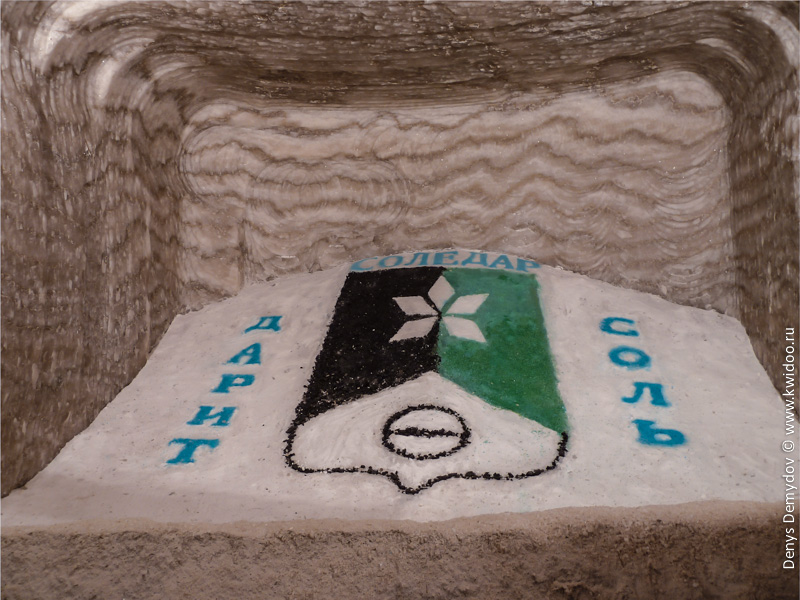
This is the largest salt production in the European part of the CIS, thanks to the Ukrainian company Artyomsol, which in Soviet times accounted for 40% of the total rock salt production of the Union. Today, the salt of this enterprise is sold not only in Ukraine and Russia, but also exported to 21 other countries: Austria, Armenia, Azerbaijan, Belarus, Bulgaria, Hungary, Germany, Georgia, Denmark, Israel, Kazakhstan, Latvia, Lithuania, Moldova, Poland, Romania, Serbia, Slovakia, Finland, Czech Republic, Estonia and Finland.
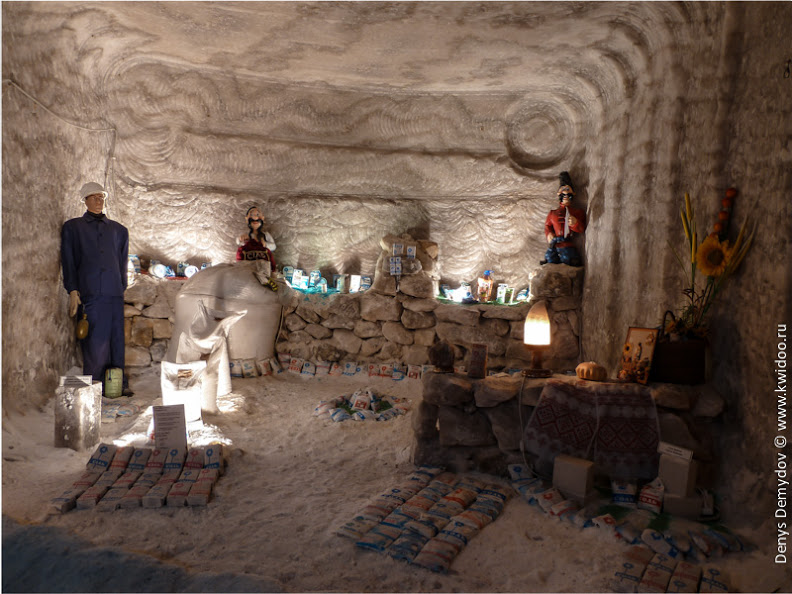
The tour of the mine begins with the distribution of helmets (so that if something falls on your head, it won’t kill you) and a briefing. During the briefing you will be warned that it is better not to go in with bad health, that no one is responsible for you, and so on. It is important not to miss the basic information amidst all the intimidation and nonsense: do not touch the metal doors at the entrance, as they are under high pressure, and do not stick any part of your body out of the car while going down the elevator shaft.
The descent into the mine is a bit challenging. You will be lowered into the mine at a speed of 4 meters per second at a depth of more than 280 meters and led down one of the numerous corridors (and their total length is more than 200 km). Salt mining was stopped in this area several decades ago, and it has been open to tourists since 1993. There is also a speleosanatorium “Salt Symphony”, which is a must for people suffering from asthma, allergies and others. After 80 years, the church where the miners pray has been reopened. It is said to be a whole underground temple (!), but it is located in the active mines and tourists are not invited there. But they show a small corner for prayers. The atmosphere is very amazing, because it is incredibly quiet, despite the presence of dozens of people. It’s not like a church at all… It’s hard to describe with words.

Everything inside the “tourist” excavation (I mean sculptures) is made of pure salt, mined here. So you can fool around by licking the statues and walls. I didn’t do it, but people were really into it. We had a terribly superstitious guide, so we kissed the statues 😅.
But not everyone dared to lick the statues. And of course the nice ladies listened carefully to the basic information, which they warned about right away: the statue at the entrance is the only one not made of salt. At the end of the excursion I heard surprised exclamations – the girls tasted the statue, it turned out to be plaster.
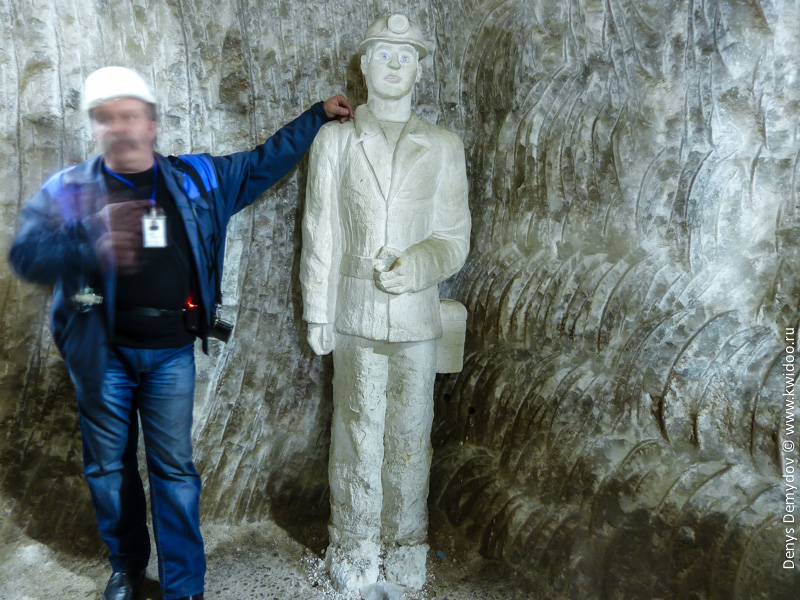
It’s an incredible feeling after descending. Like a science fiction action film. Everything around you seems to be unreal. Inside – in the thickness of rock salt, at a depth of over 300 meters. At first – a small crack, literally, on the wall. The difference in altitude, the pressure – you have to let your vascular system recover. It feels like landing an airplane.
The mine has a year round temperature of +15 degrees Celsius. This is worth considering if you are traveling in hot weather, so that you have something to put on, or in winter, so that you can easily take off all the excess. You won’t want to be dragging your jacket through the tunnel.

You can clearly see the amazing shape of the walls and ceiling of the tunnel. These are the tracks left by the URAL 20 KC combine harvester. I do not have a photo of this machine, and I have never seen it in person, so I had to turn to the Internet for help. Very quickly I found photos and the most important – an entertaining video. The video shows the work of this combine in laying a mine.
That is why we have corridors like this one. Here, the salt is not as snow-white as in the new ones, because it has absorbed the dirt over the years. But the layers are still clearly visible. In fact, the salt deposit began to form 250 million years ago as a result of salt deposition from ancient seas and their drying up. Light and dark rings alternate, reminiscent of the rings on a tree trunk. That the light ones are times of constant climate and the dark ones are times of variations in climate. These same dark layers give the salt those very dark grains that we unknowingly say in the kitchen that “salt is dirty”. It turns out that it is not.

I was particularly impressed by the patterns on the ceiling. You could probably spend hours looking at them. Of course, it was difficult to capture all the beauty with my soapbox, but I sincerely tried. All photos were taken at the lowest available ISO, and I averaged the images to get rid of the noise… But I forgot to click on the gray card, and as a result – I did not add the normal BB to any of the pictures. It’s my own fault, I was lazy or forgot.

Like I said, it’s a sanatorium. So there must be facilities? – you ask. Of course there are! The electricity didn’t surprise me much, but the excellent cell phone signal (all 5 sticks!) did. I hadn’t expected it.
In general, this museum, sanatorium – a great example of the fact that if you want, even in Ukraine, with our brilliant leaders can do business. These are the mines number 1, 2 and 3. They were supposed to be abandoned, but a museum (which became the most popular tourist attraction in the region during EURO 2012) and a sanatorium were organized here. It should be noted that the mines, the museum and the Artemsol company are still owned by the state and have not been privatized.

There are a lot of salt sculptures in the mine. One of the most famous is the image of “Martselov’s Palm”, the symbol of Donetsk. The original palm was forged from rails at the end of the 19th century and won the Grand Prix at the International Industrial Exhibition in Paris in 1900. Now the palm tree is on the coat of arms of Donetsk, and an unknown sculptor made a copy from salt. It looks quite interesting.
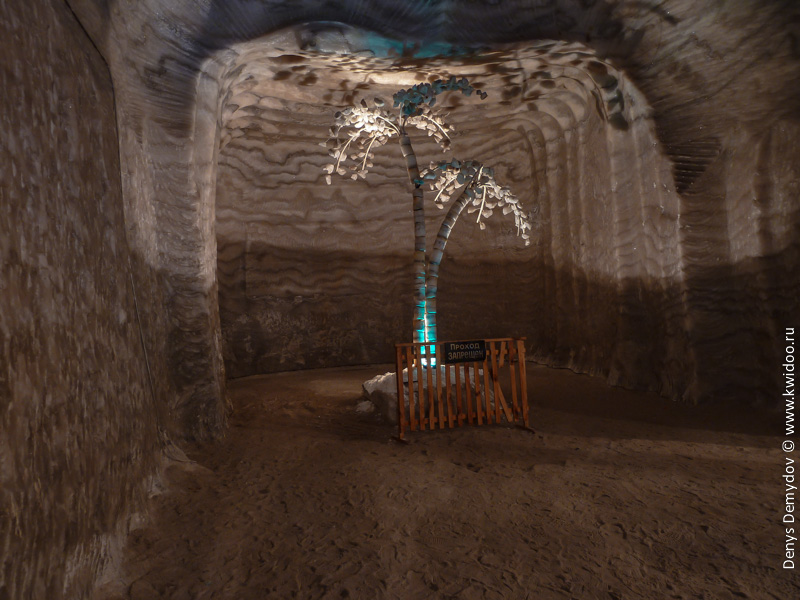
In addition, there are many other no less interesting characters, each of which is shrouded in legend. For example, there is a gnome who needs to be caressed on the spot that ails you and then kissed on the nose. Then the illness will disappear. Or these two beautiful, loving swans made of salt crystals that look great in composition and even with lighting. In the weave between their necks you have to throw a coin to find love. I threw one.

After walking through the corridors, we went to Hall 41-BIS. This hall, in the thickness of salt, at the bottom of the ancient sea, is the size of a nine-story house! Just think of the numbers: 14 meters wide, 30 meters high and 750 meters long.
In 2003, the hall was entered into the Guinness Book of World Records. The first underground balloon flight took place here. Unique symphonic concerts were held here under the direction of the best Austrian conductors (imagine the acoustics!). You can also play soccer here ⚽.
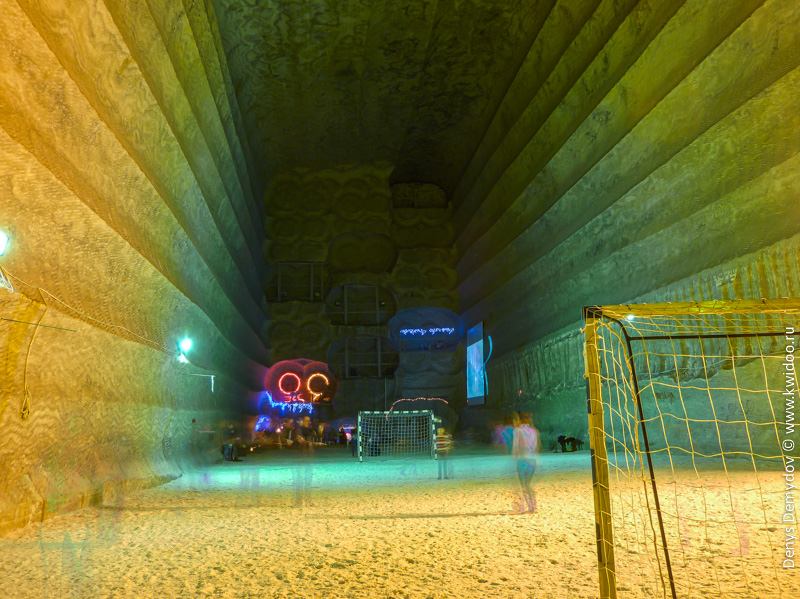
Behind the hall on this side there is a cafe, a projector with movies about the mine and benches. On the benches you can throw your things, take off your shoes (if you want, the salt under your feet is +14 degrees) and just get high on life. Play football, lick the walls, scream, experience the echo or just walk around and think about the meaning of existence.
This is also where some extreme people celebrate New Year’s Eve, apparently, as there were Christmas trees, footprints from a large tree, and other trappings on the opposite side of the hall that made me think so.
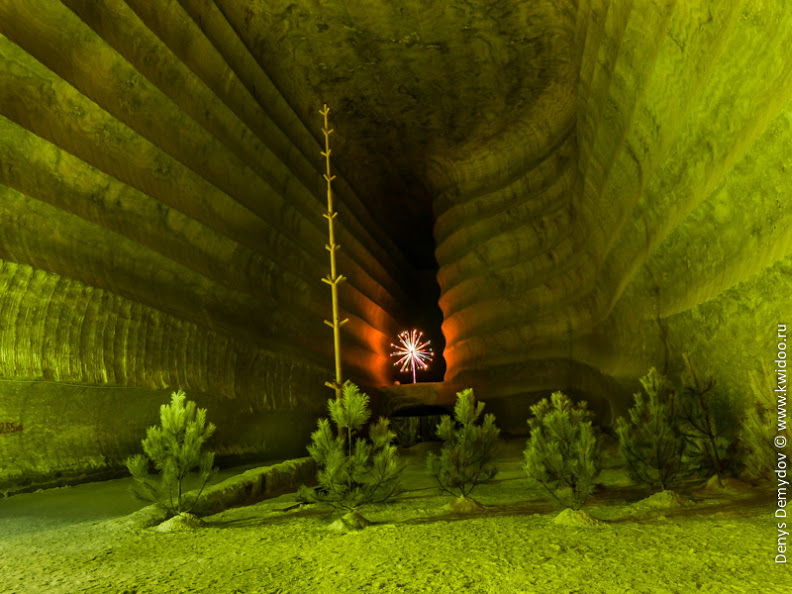
That was the tour. Is it worth going? Absolutely! The tour costs 100 hryvnias and takes place every day except Mondays and holidays. Excursions take place at 11:00, 13:00 and 15:00.
How to get to Soledar?
The city was destroyed by fighting in 2023. It is impossible to visit these areas.
— — —
On the way back we stopped in the city of Krasnoarmeysk. Near the cathedral. I took a picture.
By the way, what is the temple? I couldn’t find out exactly. From what I found out – it seems to be the village of Novoekonomicheskoe, the Church of the Nativity of the Blessed Virgin Mary, and it is more than 100 years old. Under the Soviets in 1937 it was badly destroyed and turned into a grain storehouse. After the Germans arrived in 1942, the church was first turned into a stable, but soon it was opened to the public and services were resumed. After the return of the Communists, it was not possible to prohibit services here again. You can read more about the history of this temple here. The story is really interesting.
And now I find out that I’ve only seen the side of it!

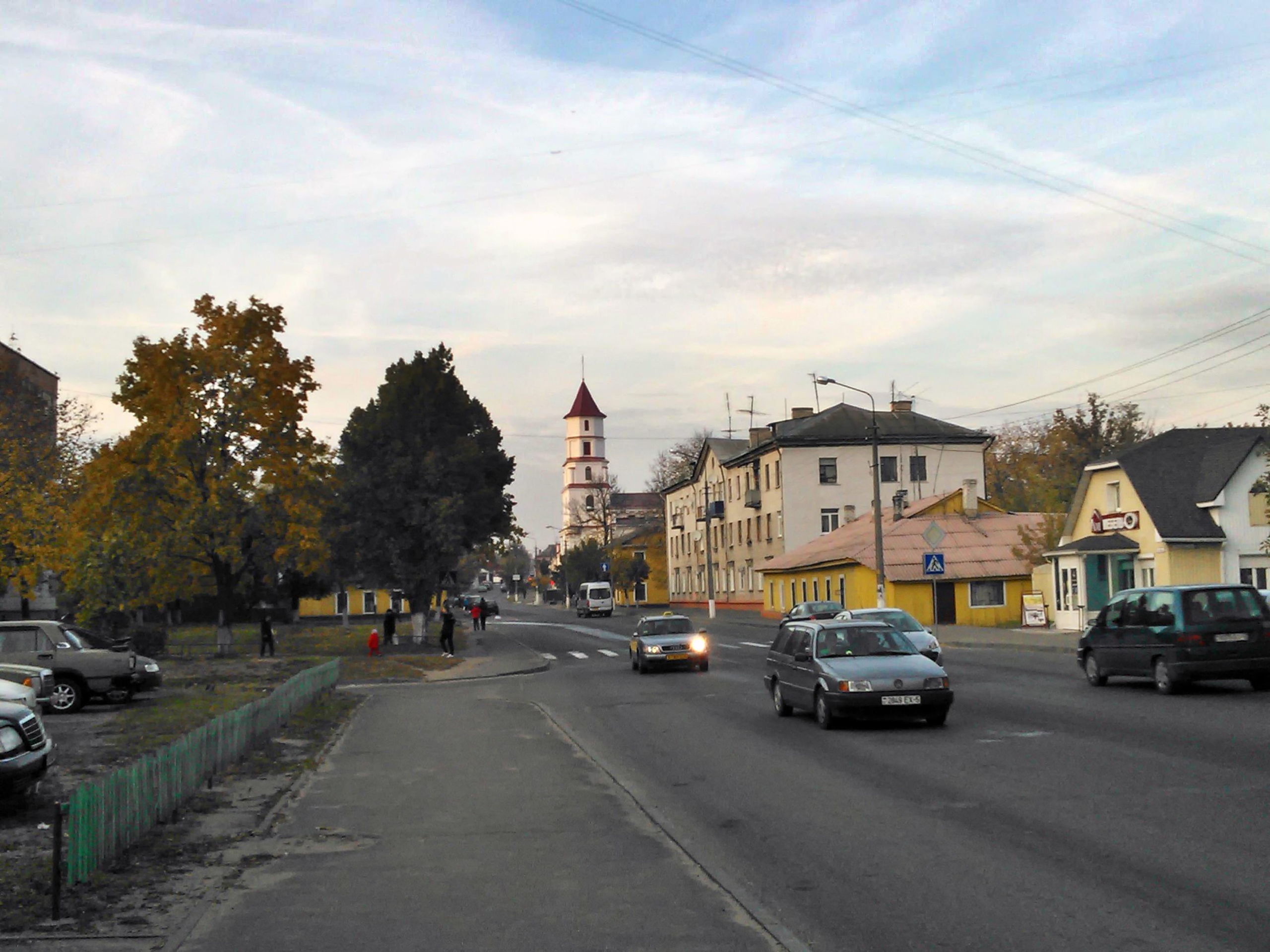


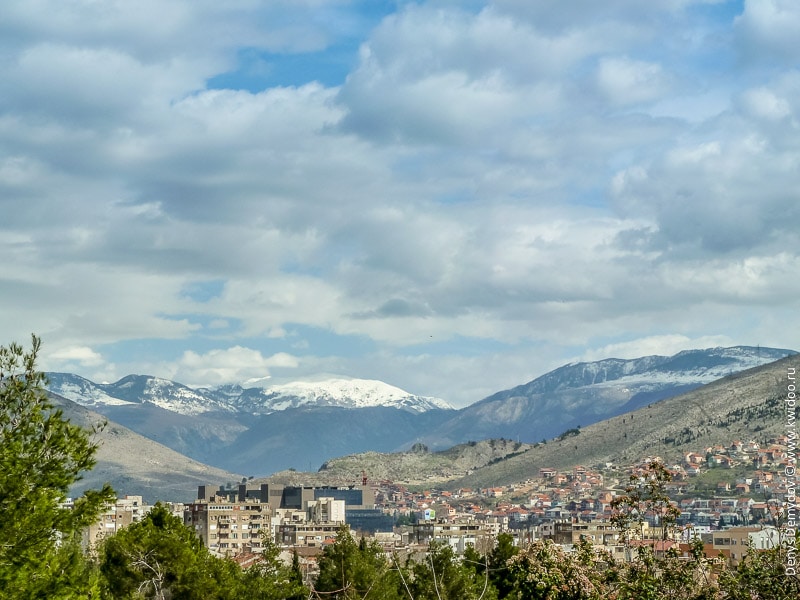
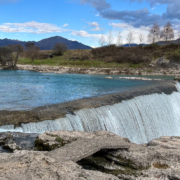


Leave a Reply
Want to join the discussion?Feel free to contribute!